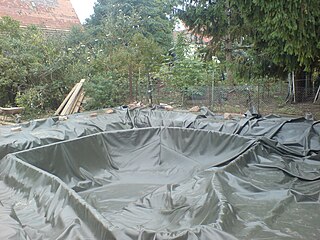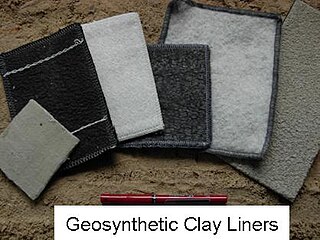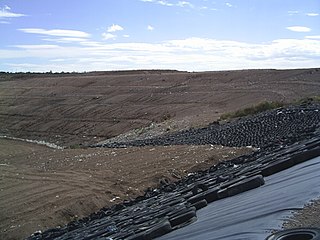
Geotechnical engineering, also known as geotechnics, is the branch of civil engineering concerned with the engineering behavior of earth materials. It uses the principles of soil mechanics and rock mechanics to solve its engineering problems. It also relies on knowledge of geology, hydrology, geophysics, and other related sciences.

A leachate is any liquid that, in the course of passing through matter, extracts soluble or suspended solids, or any other component of the material through which it has passed.

Geosynthetics are synthetic products used to stabilize terrain. They are generally polymeric products used to solve civil engineering problems. This includes eight main product categories: geotextiles, geogrids, geonets, geomembranes, geosynthetic clay liners, geofoam, geocells and geocomposites. The polymeric nature of the products makes them suitable for use in the ground where high levels of durability are required. They can also be used in exposed applications. Geosynthetics are available in a wide range of forms and materials. These products have a wide range of applications and are currently used in many civil, geotechnical, transportation, geoenvironmental, hydraulic, and private development applications including roads, airfields, railroads, embankments, retaining structures, reservoirs, canals, dams, erosion control, sediment control, landfill liners, landfill covers, mining, aquaculture and agriculture.

Geotextiles are permeable fabrics which, when used in association with soil, have the ability to separate, filter, reinforce, protect, or drain. Typically made from polypropylene or polyester, geotextile fabrics come in two basic forms: woven and nonwoven.

A pond liner is an impermeable geomembrane used for retention of liquids, including the lining of reservoirs, retention basins, hazardous and nonhazardous surface impoundments, garden ponds and artificial streams in parks and gardens.
Landscape products refers to a group of building industry products used by garden designers and landscape architects and exhibited at trade fairs devoted to these industries. It includes: walls, fences, paving, gardening tools, outdoor lighting, water features, fountains, garden furniture, garden ornaments, gazebos, garden buildings, pond liners.

Geocomposites are combinations of two or more geosynthetic materials for civil engineering applications that perform multiple geosynthetic functions. Such composite materials enhance technical properties of the soil or the geotechnical structure, while minimizing application costs.
A geomembrane is very low permeability synthetic membrane liner or barrier used with any geotechnical engineering related material so as to control fluid migration in a human-made project, structure, or system. Geomembranes are made from relatively thin continuous polymeric sheets, but they can also be made from the impregnation of geotextiles with asphalt, elastomer or polymer sprays, or as multilayered bitumen geocomposites. Continuous polymer sheet geomembranes are, by far, the most common.

Geosynthetic clay liners (GCLs) are factory manufactured hydraulic barriers consisting of a layer of bentonite or other very low-permeability material supported by geotextiles and/or geomembranes, mechanically held together by needling, stitching, or chemical adhesives. Due to environmental laws, any seepage from landfills must be collected and properly disposed of, otherwise contamination of the surrounding ground water could cause major environmental and/or ecological problems. The lower the hydraulic conductivity the more effective the GCL will be at retaining seepage inside of the landfill. Bentonite composed predominantly (>70%) of montmorillonite or other expansive clays, are preferred and most commonly used in GCLs. A general GCL construction would consist of two layers of geosynthetics stitched together enclosing a layer of natural or processed sodium bentonite. Typically, woven and/or non-woven textile geosynthetics are used, however polyethylene or geomembrane layers or geogrid geotextiles materials have also been incorporated into the design or in place of a textile layer to increase strength. GCLs are produced by several large companies in North America, Europe, and Asia. The United States Environmental Protection Agency currently regulates landfill construction and design in the US through several legislations.

A landfill liner, or composite liner, is intended to be a low permeable barrier, which is laid down under engineered landfill sites. Until it deteriorates, the liner retards migration of leachate, and its toxic constituents, into underlying aquifers or nearby rivers, causing potentially irreversible contamination of the local waterway and its sediments.

Cellular confinement systems (CCS)—also known as geocells—are widely used in construction for erosion control, soil stabilization on flat ground and steep slopes, channel protection, and structural reinforcement for load support and earth retention. Typical cellular confinement systems are geosynthetics made with ultrasonically welded high-density polyethylene (HDPE) strips or novel polymeric alloy (NPA)—and expanded on-site to form a honeycomb-like structure—and filled with sand, soil, rock, gravel or concrete.
A geonet is a geosynthetic material similar in structure to a geogrid, consisting of integrally connected parallel sets of ribs overlying similar sets at various angles for in-plane drainage of liquids or gases. Geonets are often laminated with geotextiles on one or both surfaces and are then referred to as drainage geocomposites. They are competitive with other drainage geocomposites having different core configurations.
Solid waste landfills can be affected by seismic activity. The tension in a landfill liner rises significantly during an earthquake, and can lead to stretching or tearing of the material. The top of the landfill may crack, and methane collection systems can be moved relative to the cover.
Final cover is a multilayered system of various materials which are primarily used to reduce the amount of storm water that will enter a landfill after closing. Proper final cover systems will also minimize the surface water on the liner system, resist erosion due to wind or runoff, control the migrations of landfill gases, and improve aesthetics.
Electrical liner integrity surveys, also known as leak location surveys are a post-installation quality control method of detecting leaks in geomembranes. Geomembranes are typically used for large-scale containment of liquid or solid waste. These electrical survey techniques are widely embraced as the state-of-the-art methods of locating leaks in installed geomembranes, which is imperative for the long-term protection of groundwater and the maintenance of water resources. Increasingly specified by environmental regulations, the methods are also applied voluntarily by many site owners as responsible environmental stewards and to minimize future liability.
Ronald Kerry Rowe, OC, BSc, BE, PhD, D.Eng, DSc (hc), FRS, FREng, NAE, FRSC, FCAE, Dist.M.ASCE, FEIC, FIE(Aust), FCSCE, PEng., CPEng. is a Canadian civil engineer of Australian birth, one of the pioneers of geosynthetics.
Geotextiles and Geomembranes is a bimonthly peer-reviewed scientific journal. It is the official journal of the International Geosynthetics Society and published on their behalf by Elsevier. The journal covers all topics relating to geosynthetics, including research, behaviour, performance analysis, testing, design, construction methods, case histories, and field experience.
Jorge G. Zornberg is Professor and Joe E. King Chair in Engineering in the geotechnical engineering program at the University of Texas at Austin. He has over 35 years' experience in geotechnical and geoenvironmental engineering. He is also one of the pioneers of geosynthetics.

The International Geosynthetics Society (IGS) is an engineering professional society focused on the field of geosynthetics, which are polymeric materials used in geotechnical engineering. The IGS describes itself as "a learned society dedicated to the scientific and engineering development of geotextiles, geomembranes, related products, and associated technologies." It was founded in Paris in 1983 as the International Geotextile Society and is a member of the Federation of International Geo-Engineering Societies, along with the International Society of Soil Mechanics and Geotechnical Engineering (ISSMGE), International Society for Rock Mechanics and Rock Engineering (ISRM), and International Association for Engineering Geology and the Environment (IAEG).
Double liner A double liner is a fluid barrier system that incorporates two impermeable layers separated by a permeable drainage layer also called a leak detection layer. Typically the impermeable layers are made from geomembranes with a permeable geosynthetic layer in between. The uppermost layer is called the primary liner while the lower layer is called the secondary liner. This combination of layers is designed to prevent hydraulic head from building on the secondary liner thereby limiting or preventing any permeation into the secondary liner. The first double geomembrane liner system was designed by geosynthetics pioneer, J.P. Giroud, and installed in 1974 in Le Pont-de-Claix, France to serve as a water reservoir which is still in service today. This system was composed of an early form of a bituminous geomembrane as the secondary liner, gravel as the drainage layer, and a butyl rubber geomembrane as the primary liner.










